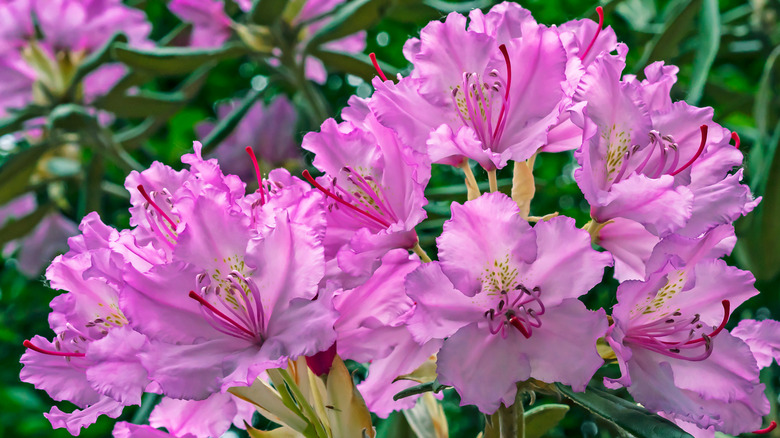Washington's State Flower Is A Flowering Shrub Sure To Attract Hummingbirds
We may receive a commission on purchases made from links.
Are you looking to attract hummingbirds to your yard year-round? Summer and early fall are usually easy, as there are plenty of nectar-producing flowers to draw the birds in. In winter time, plants like witch hazel and camellias are also a notable nutrition source for the birds. But what about in spring, when resident species like Calliope and Anna's Hummingbirds make their way up the west coast, but few flowers are in bloom? Well, look no further than Washington's gorgeous state flower — the Pacific rhododendron (Rhododendron macrophyllum). This rhododendron variety starts to bloom in May in USDA Hardiness zones 6b through 10a, adorning the Pacific coast from the northern tip of California to southwestern British Columbia. Growing this shrub on your property is a great way to attract hummingbirds to your yard in the spring.
Pacific rhododendrons do much more than draw the little hovering beauties to your yard. These flowering shrubs also grace your landscape with large, luxuriant, colorful blooms and year-round green foliage. Below, you'll find out how to plant rhododendrons along with a few best practices for ongoing care.
How to grow the Pacific rhododendron
First, find your Pacific rhododendrons a suitable location. These are understory plants, so if you have large trees on your property, plant the rhododendrons beneath their canopy. If your yard doesn't have a shady corner, find a place that offers at least partial shade. Just note that the more sun the plants receive, the smaller they will end up growing. Planting rhododendrons in a spot with full sun is not recommended, as the plants won't flourish at all. Apart from the tricky lighting demands, consider the soil conditions in your yard. Rhododendrons prefer well-draining, aerated soil that's rich in humus and high in acidity — pH levels of 4.5 to 6 are preferable. Find out how to measure the pH of your soil if you're not sure.
Once you've selected an appropriate site, plant the rhododendrons around 10 to 13 feet apart. They'll need the space when they mature, since these shrubs can grow as wide as 14 feet. Newly planted rhododendrons require regular irrigation, and their leaves should not be allowed to wilt for a prolonged duration. The soil should be moist at all times, and you can check this by sticking your fingers into the soil beneath the foliage farthest from the trunk. If the soil sticks to your hands, then it's moist enough. If it doesn't, then you need to irrigate. Mature plants demand less care with each passing year, and are generally drought-tolerant.
Ongoing care for the Pacific rhododendron
Rhododendrons flourish in fertile soil, and if their growing location lacks nutrients, you'll need to fertilize the plants properly. To establish whether additional nutrients are needed, you can make a DIY test to check the health of your soil. If the test indicates a nutrient deficiency, you can use a complete fertilizer tailored to plants that prefer acidic soil, like this one from Amazon. When fertilizing your plants, be sure not to exceed the fertilizer amounts the manufacturer specifies for rhododendrons, otherwise you risk damaging their roots. Timing matters, too. If you fertilize your rhododendron plants with nitrogen-containing fertilizer once the summer season is underway, you'll encourage new growth from the plant. These new shoots will be vulnerable to frost damage. Instead, if you must add plant food, do so before the middle of June.
If your Pacific rhododendrons are starting to look unkempt, encroach on nearby flower beds, or you simply want to shape them, you can prune them and they should respond well to the procedure. The ideal time for cutting back your rhododendrons depends on what you're trying to accomplish. If you're pinching back the plant to encourage new growth, do so during the growing season. Meanwhile, it's best to cut off hardened wood early in the spring — this way, new shoots have lots of time to mature during the growing season. Finally, deadheading flowers should be done as soon as the blooms begin to fade.


